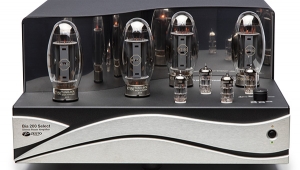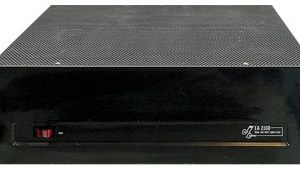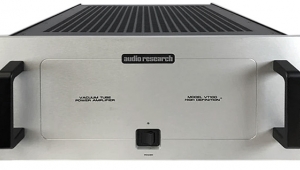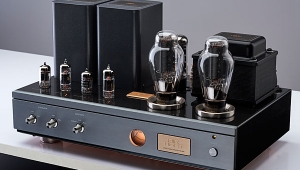| Columns Retired Columns & Blogs |
Manley Laboratories 250 Neo-Classic monoblock power amplifier Measurements
Sidebar 3: Measurements
With both balanced and unbalanced inputs and an output stage capable of operating in both tetrode and triode modes, the Manley 250 Neo-Classic is four amplifiers in one chassis and thus represents four times as much labor in the measuring lab. I therefore reduced the variables by performing a complete set of tests running the amplifier balanced in tetrode mode, and repeated several of the tests in triode mode and via the unbalanced input, as necessary.
The Manley amplifier is noninverting through both inputs, the XLR wired with pin 2 hot. The input impedance at 1kHz was very high, at 300k ohms balanced and 128k ohms unbalanced, though these figures fell to a still high 90k ohms and 81k ohms, respectively, at 20kHz. The unbalanced tetrode sensitivity into 8 ohms was average, at 25.9dB. However, the balanced input reduced this to 18.8dB, and changing to triode mode reduced it further, to 17.4dB. If you wish to drive the Manley's balanced input directly, without a preamp, very few CD players have enough output voltage to drive the amplifier even close to clipping.
The output impedance at 1kHz was quite low for a tube design, at 0.7 ohm in tetrode mode and 0.6 ohm triode, these figures rising inconsequentially by 0.05 ohm at the edges of the audioband. The interaction between the 250 Neo-Classic's source impedance and Stereophile's standard simulated speaker load was a moderate ±0.4dB in either mode, which can be seen in the plots of the amplifier's frequency response (fig.1, tetrode; fig.2, triode).

Fig.1 Manley 250 Neo-Classic, tetrode mode, frequency response at (from top to bottom at 2kHz): 2.83V into dummy loudspeaker load, 1W into 8 ohms, 2W into 4 ohms, 4W into 2 ohms (1dB/vertical div.).

Fig.2 Manley 250 Neo-Classic, triode mode, frequency response at (from top to bottom at 2kHz): 2.83V into dummy loudspeaker load, 1W into 8 ohms, 2W into 4 ohms, 4W into 2 ohms (1dB/vertical div.).
What is more apparent in these graphs is the presence of a response peak at 70kHz. This is higher in tetrode mode than in triode, reaching 4dB compared with 1.2dB. The height of the peak also decreases into lower impedances, but only in triode mode. The subjective consequences of the peak are probably mild to nonexistent, but might suggest a modicum of sensitivity to cable choice. These graphs were taken with a balanced input; the picture was very similar via the unbalanced input, but with a slightly less high ultrasonic peak: 2.4dB vs 4dB in tetrode mode.
Where the peak does reveal itself is in the Manley's squarewave responses. Fig.3 shows the output waveform with the amplifier in tetrode mode driving 10kHz into 8 ohms; fig.4 is with the amplifier in triode mode. As anticipated from the response graphs, there is less ringing, with less of a leading-edge overshoot, in triode mode.

Fig.3 Manley 250 Neo-Classic, tetrode mode, small-signal 10kHz squarewave into 8 ohms.
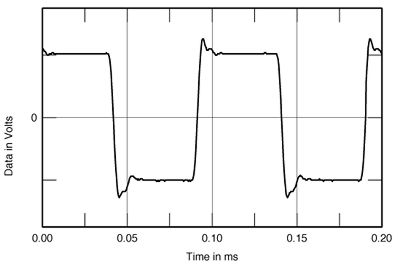
Fig.4 Manley 250 Neo-Classic, triode mode, small-signal 10kHz squarewave into 8 ohms.
The 250 Neo-Classic was fairly quiet; its unweighted, wideband signal/noise ratio ref. 1W into 8 ohms measured 77.5dB. This improved slightly, to 80.2dB, when the measurement bandwidth was reduced to 22Hz-22kHz—and by more, to 89.6dB, when the reading was A-weighted, due to the weighting filter rejecting a very small amount of 60Hz hum. Figs.5 and 6 show how the Manley's small-signal distortion+noise reading varied with frequency in tetrode and triode modes, respectively. The level is higher in triode mode than in tetrode, but both modes are respectively low into impedances of 4 ohms and higher, at least between the midbass and the top audio octave. There is a small rise in tetrode distortion in the low bass—unusually, this is greatest into 16 ohms—and a greater low-frequency rise in triode mode. Of more consequence is the rise in distortion at the top of the audioband, which is greater in tetrode mode.
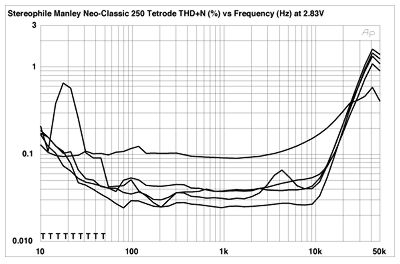
Fig.5 Manley 250 Neo-Classic, tetrode mode, THD+N (%) vs frequency at 2.83V into (from bottom to top at 1kHz): 16 ohms, simulated loudspeaker load, 8 ohms, 4 ohms, 2 ohms.

Fig.6 Manley 250 Neo-Classic, triode mode, THD+N (%) vs frequency at 2.83V into (from bottom to top at 1kHz): 16 ohms, simulated loudspeaker load, 8 ohms, 4 ohms, 2 ohms.
- Log in or register to post comments
